1454 Highway 161 North
The Yorkville Enquirer of Aug. 15, 1872 reported – “Your editor attended an examination and exhibition at the Seymore School House near Bethany Church in Kings Mountain Township. The school is taught by Prof. Ira Ervin of Cleveland, N.C. The crowd present was estimated at 1,000.”
City Directories and History: This is one of York County’s oldest ARP congregations, formed in circa 1797. The first recorded minister here was the Rev. William
Dickson who served the area for over thirty years. Due to the length of his minister the church was often refereed to as the Dickson’s Meetinghouse. The original three meeting houses were all of frame construction until the current church building was erected in 1914, for a total cost of $12,000., of which the windows cost $452.96. Mr. Falls of Kings Mountain made the brick on site for the church and the windows were reported to have cost $452.96. The church shows clearly on the Walker map in 1910 but not in the present condition.

The postal map of York County, S.C. in 1896 – Courtesy of the UN. of N.C.
The church was constructed at a time when Gothic Revival architecture was heavily in use. See More Information / PDFs for article on the church.
“Bethany (“House of the Poor”), 1797, York County. See The Gospel of John, 12:1—“Then Jesus six days before the pass over came to Bethany, where Lazarus was. . . .”
Information from: Names in South Carolina by C.H. Neuffer, Published by the S.C. Dept. of English, USC
The first Elders that were elected and ordained at Bethany were as follows: William McElwee, Sr., who had been a Ruling Elder in the General Assembly body; Samuel Lesslie, James Crawford, and Alexander Henry. These were installed in office and Bethany was organized in 1797 on the spot it now stands, then an unbroken point. According to the statement of Francis Henry, the stand was erected at Bethany, and that became a place of worship in 1796 which die writer is inclined to receive as the proper date. The first time the Lord’s Supper was dispensed to this organization was at a stand at the head of a ravine leading up from the spring to the present church, where the wild deer and wolf found safe retreat in these boundless woods.
In March 1796, Rev. William Dixon moved his family into the bounds from Cedar Spring, Abbeville District. In 1801 Peter Galloway and James Montgomery moved into the bounds and they had both been elders, were selected to serve in that capacity over Bethany congregation. William Dixon was of Scotch-Irish extraction. He obtained his theological education under the celebrated John Brown of Haddington. Bethany engaged his services for about 35 years. After the death of Mr. Dixon, Rev. Mr. Banks served them for a few months. His successor was Dr. Grier, who served about eight years. I have not touched on the most interesting topic in the history of Bethany, viz.: Their change of Ecclesiastical connection from the A. R. synod to the Associate Synod, and thence back to the A. R. church again. These are all matters of record, and the historian may find them as readily as the writer. Present [1859] statistics: Pastor E. E. Boyce; number of families, 41; communicants, white, 95; communicants, black, 11; contributions to domestic missions, 00; contributions to foreign missions, $20.20. Information courtesy of YCGHS — June 1995
BETHANY CHURCH – by Rev. E. E. Boyce
(The following is copied from the Yorkville Enquirer, June 23, 1859. The Enquirer noted that they had copied the account from “a late number of the Due West Sketch.” The article was attributed to Rev. E. E. Boyce who stated that he got most of his information from William McElwee, “who died in 1854, was an active mature man through several years of the close of the last century” and from Francis Henry who was still living. Boyce said that Francis Henry was able to drive stock from Kings Mountain to Philadelphia in 1796. The fathers of the two men had been active in the establishment of Bethany in 1793.
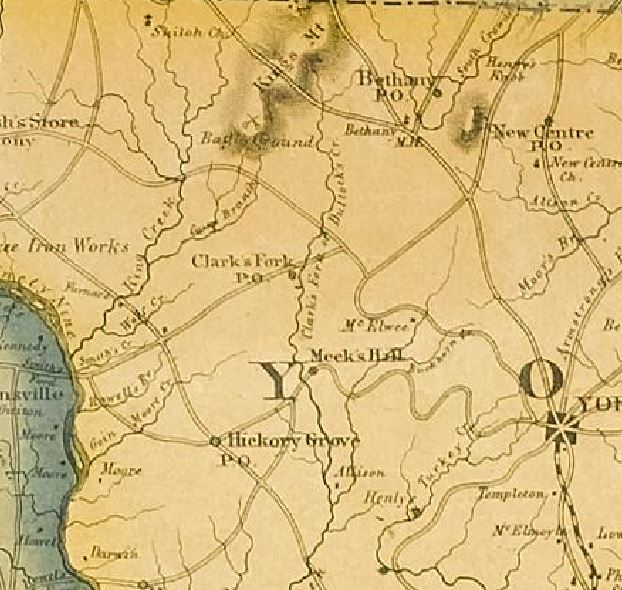
Section of Colton’s 1854 S.C. Map showing the location of Bethany Church and Community.
By 1859 the small town of Due West, S. C. was (and still is) the center of Associate Reformed Presbyterian teaching [Erskine College is the home of Erskine Theological Seminary], the Synod of the South, and publications, mainly “The Christian Magazine of the South,” ‘The Erskine Miscellany,” and “The Due West Telescope.” We could not find information on the Due West Sketch. Dr. Lowry Ware does not mention it in his recently published book, Associate Reformed Presbyterian Death & Marriage Notices from The Christian Magazine of the South, The Erskine Miscellany and The Due West Telescope, 1843- 1863, Columbia, SC: SCMAR, 1993.)
Previous to the year 1793, all the Presbyterians in the vicinity of Kings Mountain worshipped together. The principal churches were Beersheba, York District, and Long Creek, N. C. About 1793 the harmony of the congregation was broken by the introduction of hymns, which, to a respectable minority, was an innovation not to be borne with and consequently led to a division in the ranks. The A. R. Church of the Carolinas was the only hope of the psalm-singing party, and they at once leaned in that direction and Andrew Ferguson and John Miller attended the meeting of that body on Black River, S. C. as delegates to obtain supplies. It would appear that the psalm-singing party of Beersheba claimed the right of worshiping in the old place, for tradition has it that James Rodgers, the first A. R. minister who came to preach to them, met a Rev. McWhorter at Beersheba and both claimed the pulpit Mr. McWhorter courteously declined to preach one part of the day, which offer Mr. Rodgers did not accept, affirming that they were both ordained to preach and it was the duty of both to preach that day. So, Mr. Rodgers adjourned with a part of the congregation to a private house. That day the A. R. Church became a reality in upper York and has for sixty-five or seventy years maintained a connection with that body, the A. R. Church or their cousins-German, the Associate Synod of North America. The names of her persons who were the nucleus of this congregation were the following: William McElwee, Sr., who had been a Ruling Elder in Beersheba; and his sons, John McElwee, Jr., (Postmaster at McElwee’s Store), and William McElwee, both of whom were in later years Elders in Bethany; William Henry_ Alexander Henry, James Henry, James Crawford, William Crawford, Francis Rea, James Dunn and Joseph Carroll. These, with some others, petitioned for the stated labors of William Dixon, a licentiate of the A. R. body, and for 18 months or two years worshipped at the head of Crowder’s Creek on the south base of the pinnacle of Kings Mountain in North Carolina, in a small log house erected especialy for their accommodation by their joint efforts with the body which now forms Pisgah. That old church, I am informed is now, 1859, doing the menial service of a bam on the premises of a Portuguese farmer, near by – formerly owned by George Ferguson.
The people, worshippers of this Kings Mountain house, united with Sharon and Carmel in a call for Rev. William Dixon, who accepted and ordained and installed at Sharon in the year 1797. Dr. John Hemphill, Rev. James Rodgers and Rev. Mr. McMillan officiating. The first Elders that were elected and ordained at Bethany were as follows: William McElwee, Sr., who had been a Ruling Elder in the General Assembly body; Samuel Lesslie, James Crawford, and Alexander Henry. These were installed in office and Bethany was organized in 1797 on the spot it now stands, then an unbroken point. According to the statement of Francis Henry, the stand was erected at Bethany, and that became a place of worship in 1796 which the writer is inclined to receive as the proper date. The first time the Lord’s Supper was dispensed to this organization was at a stand at the head of a ravine leading up from the spring to the present church, where the wild deer and wolf found safe retreat in these boundless woods.
In March 1796, Rev. William Dixon moved his family into the bounds (of the Bethany Church), from Cedar Spring, Abbeville District. In 1801 Peter Galloway and James Montgomery moved into the bounds and they had both been elders, were selected to serve in that capacity over Bethany congregation. William Dixon was of Scotch-Irish extraction. He obtained his theological education under the celebrated John Brown of Haddington. Bethany engaged his services for about 35 years. After the death of Mr. Dixon, Rev. Mr. Banks served them for a few months. His successor was Dr. Grier, who served about eight years. I have not touched on the most interesting topic in the history of Bethany, viz.: Their change of Ecclesiastical connection from the A. R. synod to the Associate Synod, and thence back to the A. R. church again. These are all matters of record, and the historian may find them as readily as the writer. Present [1859] statistics: Pastor E. E. Boyce; number of families, 41; communicants, white, 95; communicants, black, 11; contributions to domestic missions, 00; contributions to foreign missions, $20.20. [Note: The Historic Sites Survey of 1975, prepared by the Catawba Regional Council, states that the first grave in the cemetery at Bethany is of an Indian warrior and that many Revolutionary War soldiers, some of them killed at the battle of Kings Mountain, are buried there. The red brick church is located on Highway 161 about 10 miles northwest of the town of York.]
Also open the More Information link #3 (found under the primary picture), to view an 1896 Postal Map of York County, S.C.
Part of the Little White Church Jaunt – A Driving Tour – Also see PDF history this page: GUIDE TO PRESBYTERIAN NAMES AND PLACES IN SC by J.B. Martin, III – 1989
Stay Connected
Explore history, houses, and stories across S.C. Your membership provides you with updates on regional topics, information on historic research, preservation, and monthly feature articles. But remember R&R wants to hear from you and assist in preserving your own family genealogy and memorabilia.
Visit the Southern Queries – Forum to receive assistance in answering questions, discuss genealogy, and enjoy exploring preservation topics with other members. Also listed are several history and genealogical researchers for hire.
User comments welcome — post at the bottom of this page.
Please enjoy this structure and all those listed in Roots and Recall. But remember each is private property. So view them from a distance or from a public area such as the sidewalk or public road.
Do you have information to share and preserve? Family, school, church, or other older photos and stories are welcome. Send them digitally through the “Share Your Story” link, so they too might be posted on Roots and Recall.
User comments always welcome - please post at the bottom of this page.





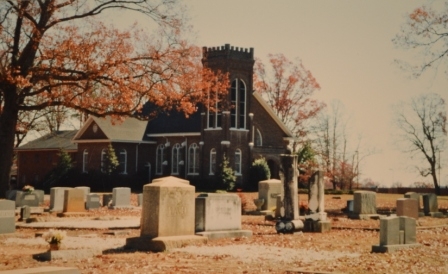
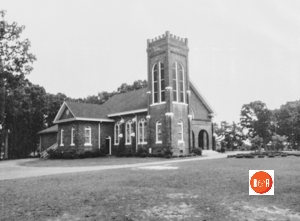

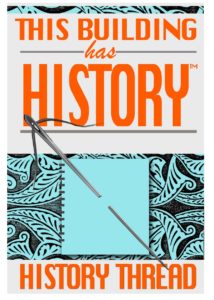


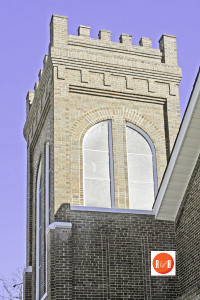

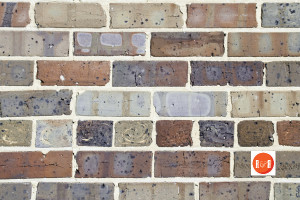



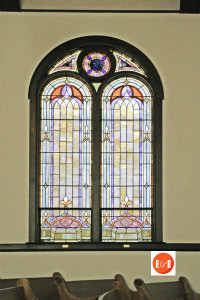





Bethany was not one of the “4-Bs”; those were Bethel, Beersheba, Bullocks Creek, and Bethesda.
Thank you for our oversight. Corrected!
I just discovered this site and I love it. I am descended from Francis Henry who married the Rev. Dixon’s daughter. I visited the church and the cemetery last year and got to talk with the current pastor. He is very knowledgable about the history of the church.
We are delighted that you are enjoying the site. Please share images and information so others too will profit from your knowledge.